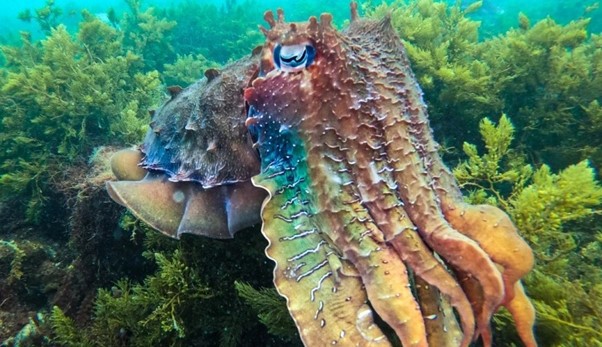
South Australia’s Giant Australian Cuttlefish breeding ground has won National Heritage listing, adding new protection to the region being scoped as a possible desalination plant site for the Upper Spencer Gulf.
The Cuttlefish Coast Sanctuary Zone near Whyalla is the 120th Australian place to make the National Heritage List alongside Uluru Kata-Tjuta, the Great Barrier Reef and the Port Arthur Historic Site in Tasmania – and is only SA’s 10th entry.
Federal Environment Minister Tanya Plibersek said the Cuttlefish Coast is one of the world’s largest Giant Australian Cuttlefish breeding sites and is listed for being a rare aspect of Australia’s natural history with potential to support further research into the species.
Every year, between May and August, thousands of giant Australian cuttlefish congregate along four kilometres of shallow rocky reef, within the Cuttlefish Coast Sanctuary Zone some 63 kilometres south of Port Augusta and 15km northeast of Whyalla.
“The annual migration of Giant Australian Cuttlefish to the Cuttlefish Coast is a natural wonder,” Plibersek said.
“The cuttlefish put on a spectacular show of colour, shapeshifting and cunning games, creating what is almost an underwater light show.
“The Cuttlefish Coast Sanctuary Zone adds outstanding heritage value to Australia’s precious coastal sanctuary zones and helps to develop an understanding of our unique natural history.”
Conservation South Australia welcomed the news, having previously called for the Point Lowly site to be dropped from a $15 million State Government scoping plan for a desalination plant in the Upper Spencer Gulf.
“The Giant Australian Cuttlefish aggregation is a spectacular natural wonder with global significance that richly deserves national recognition,” Conservation SA chief executive Craig Wilkins said.
“We humans can build all sorts of grand palaces, but it is impossible for us to recreate the magic of nature that happens around Pt Lowly every winter.
“Nature has chosen this spot, and we must do everything in our power to make sure it is protected.
“The cuttlefish breeding grounds now join a very select list of SA sites on the National Heritage register, including the Adelaide Park Lands, the Ediacaran fossils and the Naracoorte caves.”
Wilkins said the main cuttlefish breeding areas at Stony Point near the listed site was “surprisingly” not included in the listing, and “we hope it will be added in the future”.
The National Heritage List recognises places of outstanding heritage significance to Australia. It includes natural, historic, and Indigenous places, under Australia’s national environment law, the Environment Protection and Biodiversity Conservation Act 1999.
Wilkins believed the National Heritage listing “must surely rule out once and for all a desalination plant at Pt Lowly” over concerns the cuttlefish breeding cycle is strongly affected by salinity.
The latest consultation to build the plant comes 12 years after Transport and Infrastructure Minister Tom Koutsantonis approved a BHP Billiton plan to build a desalination plant at Point Lowly when he was part of the Weatherill Labor State Government.
It met resistance from environmentalists and fishers and was eventually dropped when the company’s Olympic Dam mining site expansion did not go ahead.
Koutsantonis is again the Minister overseeing the new desalination plant project, with the current business case assessment funded by the state and federal governments.
A government spokesman said the Federal Government decision to add the Cuttlefish Coast Sanctuary Zone on the Upper Spencer Gulf to the National Heritage List is welcome.
“A business case is still being developed for the proposed construction of a desalination plant under the Northern Water Supply project (NWS),” he said.
“This process is adhering to rigorous standards of environmental, economic and technical studies and analysis.
“Point Lowly is just one of three sites under consideration, along with Crag Point and Mullaquana, as part of the business case that will be delivered to government.”
The spokesman said if the government opts to proceed to the next phase, the preferred site would be subject to a range of detailed environmental studies and consultations with community and industry, including local Aboriginal communities.
“Only after these studies and consultations have been completed will the government be in a position to make a final decision on whether or not to support development of a desalination plant at any specific site, with this decision expected to be made in mid-2024,” he said.
Words: Belinda Willis
Image: Maeve Plouffe



